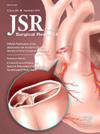Factors Associated With Surgical Management in Gallbladder Cancer—A Surveillance, Epidemiology, and End Results Medicare–Based Study
IF 1.8
3区 医学
Q2 SURGERY
引用次数: 0
Abstract
Introduction
Gallbladder cancer (GBC) incidence is rising, yet prognosis remains poor. Oncological resection of stage T1b or higher improves survival, yet many patients do not receive appropriate resection. This study aims to evaluate factors that may attribute to this discrepancy using the Surveillance, Epidemiology, and End Results–Medicare (SEER-Medicare) database.
Materials and methods
SEER Medicare (2008-2015) patients with GBC stage T1b or higher were classified as receiving cholecystectomy alone (CCY) or cholecystectomy and liver/biliary resection (oncologic resection). Outcomes and overall survival were compared, before and after propensity score matching on baseline characteristics, using Chi-square and Wilcoxon rank-sum tests for categorical and continuous variables, respectively.
Results
We identified 1129 patients of which 830 underwent CCY (58.3% early stage/41.7% late stage) while 299 had complete resection (54.2% early stage/45.8% late stage). CCY patients were more often female (73.4% versus 65.6%; P = 0.0104), ≥80 y old (48.2% versus 22.4%; P < 0.0001), frail (44.5% versus 27.1%; P < 0.0001), treated by general surgeons (98.1% versus 84.9%; P < 0.0001) versus surgical oncologists, not undergoing chemotherapy (72.3% versus 54.5%; P < 0.0001), managed at nonacademic hospitals (51.2% versus 28.4%; P < 0.0001). After matching, oncologic resection demonstrated improved overall survival compared to CCY at 1-y (69.2% versus 47.2%; P < 0.0001), 3-y (42.8% versus 21.1%; P < 0.0001), and 5-y (37.5% versus 17.4%; P < 0.0001).
Conclusions
Most GBC patients may not be receiving appropriate oncological resection, especially patients who are female, older, frail, operated on by a general surgeon, not undergoing chemotherapy, or managed at nonacademic hospitals. Even when adjusting for patient factors, complete resection is associated with overall survival outcomes at multiple endpoints. Limiting sex, age, and frail status as factors and involving surgical oncologists or receiving management at academic centers may increase oncologic resection rates and thus improve survival for GBC patients.
胆囊癌手术治疗的相关因素--基于医疗保险的监测、流行病学和最终结果研究
导言胆囊癌(GBC)的发病率不断上升,但预后仍然很差。T1b期或以上的肿瘤切除术可提高生存率,但许多患者并未接受适当的切除术。本研究旨在利用监测、流行病学和最终结果--医疗保险(SEER-Medicare)数据库评估可能导致这一差异的因素。材料和方法SEER医疗保险(2008-2015年)中T1b期或以上GBC患者被分为接受单纯胆囊切除术(CCY)或胆囊切除术和肝/胆切除术(肿瘤切除术)。对分类变量和连续变量分别采用Chi-square检验和Wilcoxon秩和检验,比较了基线特征倾向得分匹配前后的结果和总生存率。CCY 患者多为女性(73.4% 对 65.6%;P = 0.0104)、≥80 岁(48.2% 对 22.4%;P <;0.0001)、体弱(44.5% 对 27.1%;P <;0.0001)、由普通外科医生治疗(98.1%对84.9%;P <;0.0001)与肿瘤外科医生相比,未接受化疗(72.3%对54.5%;P <;0.0001),在非学术医院管理(51.2%对28.4%;P <;0.0001)。匹配后,与 CCY 相比,肿瘤切除术的总生存率在 1y (69.2% 对 47.2%; P < 0.0001)、3y (42.8% 对 21.1%; P < 0.0001) 和 5y (37.5% 对 17.4%; P < 0.0001) 均有所提高。结论大多数GBC患者可能没有接受适当的肿瘤切除术,尤其是女性、老年、体弱、由普通外科医生手术、未接受化疗或在非学术医院接受治疗的患者。即使对患者因素进行调整,完全切除仍与多个终点的总体生存结果相关。限制性别、年龄和体弱状况等因素,并让肿瘤外科医生参与或在学术中心接受治疗,可能会提高肿瘤切除率,从而改善 GBC 患者的生存率。
本文章由计算机程序翻译,如有差异,请以英文原文为准。
求助全文
约1分钟内获得全文
求助全文
来源期刊
CiteScore
3.90
自引率
4.50%
发文量
627
审稿时长
138 days
期刊介绍:
The Journal of Surgical Research: Clinical and Laboratory Investigation publishes original articles concerned with clinical and laboratory investigations relevant to surgical practice and teaching. The journal emphasizes reports of clinical investigations or fundamental research bearing directly on surgical management that will be of general interest to a broad range of surgeons and surgical researchers. The articles presented need not have been the products of surgeons or of surgical laboratories.
The Journal of Surgical Research also features review articles and special articles relating to educational, research, or social issues of interest to the academic surgical community.

 求助内容:
求助内容: 应助结果提醒方式:
应助结果提醒方式:


